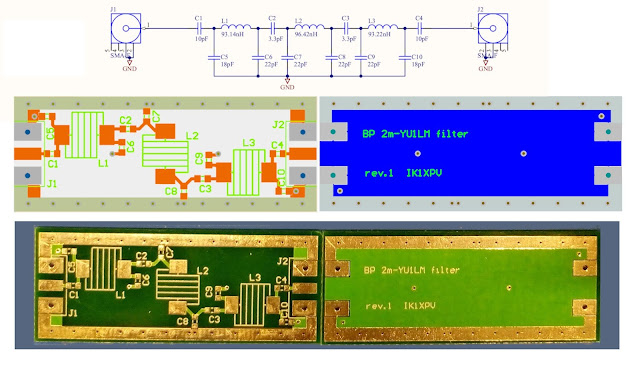A look into the RX-888 mkII
It is an evolution of the first RX888.The curiosity won out and I opened it.
Be careful if you decide to open your device because two heat pads are used to carry the heat from the R828D and the LTC2208 to the aluminium case. I managed to slide them out without damaging them by moving the PCB very gently. A plastic wide stick may help to push out the pads and after to reassemble the radio.
The PCB layout is similar to RX888
In HF the input attenuator is a PE4312 covering a 31.5 dB attenuation range. This replaces the 0, -10 ,-20 dB attenuator of RX888.
It is followed by the low pass filter at 64 MHz.
Then two switches PE4259 select the HF input or the VHF tuner R828D produced by Rafael Micro that replaces the R820T2. The added transformer connects in a balanced way to the R828D IF outputs.
An AD8370 digitally controlled variable gain
amplifier (VGA) provides precision gain control, high IP3,
and low noise figure (7 dB). It replaces the LTC6401-20 20 dB LNA in RX888.
The PCB shows a jumper and a coaxial connector that allows the use of an external reference 27 MHz clock. I have not tested this configuration.
The actual software release supports the RX-888 mkII that is automatically detected.
While testing the development branch of the software I ran both my RX888 and RX-888 mkII units up to 140 MHz of ADC clock at room temperature with no problem.
( by the way the next release will allow to program ADC clock from 50 MHz to 140 MHz ).
The greater attenuation and VGA amplifier's range improve the level range that the receiver is able to manage. Unfortunately I have not professional instruments to make an exact measurement.
In the picture there are few signals higher than 30 MHz as my antenna has a low pass filter at 30 MHz. My unit shows a weak spur near 34 MHz that moves with temperature. I have not yet located the source.
If RX-888 mk2 is the winner as sensitivity and high input level tolerance, it seems to me it has some dB higher spurs, possibly the AD8370 has a little higher distortion than RX888's LTC6401-20.






The LTC6401-20 had better noise and distortion figures than the AD8370. If the point was to increase performance the ADL5206 is a much better choice (more expensive though). Also a tin can around the tuner and the input stages is a better idea, which would provide a separation between the digital and the analogue part. It makes no sense to shield the PLL, when rest of the digital circuitry is not shielded at all. I think the design of the HackRF One is a quite good example.
ReplyDeleteMy RX-888 MK2 died recently. It is still recognized by windows device manager but not working otherwise. It was also not getting warm at all like it used to. I did have it running previously at a low sample rate (1 MHz) and it was slightly warm while working previously. I removed the pcba from the case and next step I guess is to check the regulators. Anyone have a schematic?
ReplyDeletewell that answers my question, first day out the box trying to get the thing working it was mad hot next day cool as a cucumber what a waste of money, not impressed to say the least.
Delete